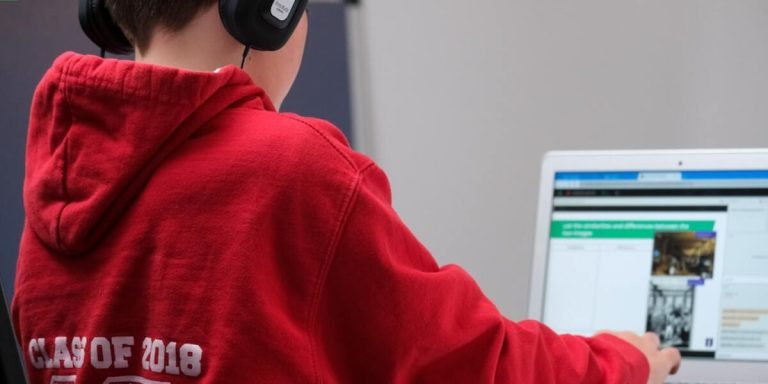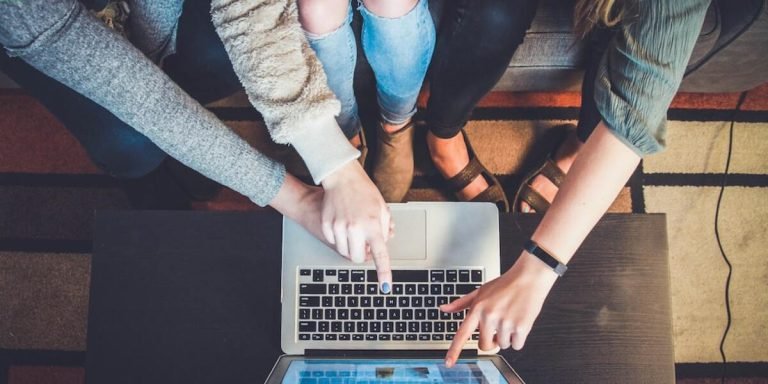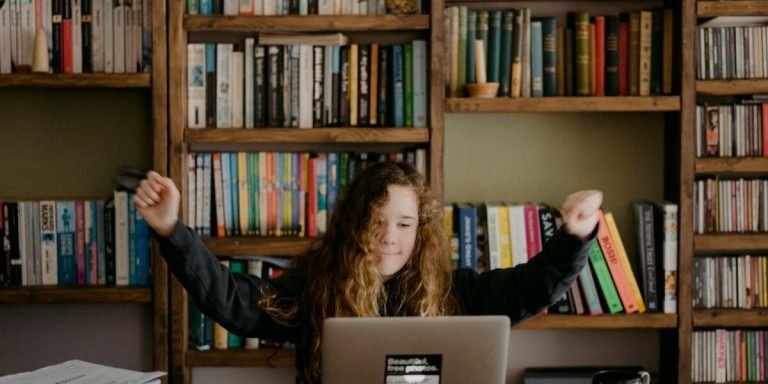What is Blended Learning and Its Impact on Childhood Education
In an era characterized by technological advancement, the phrase “what is blended learning” has become a common query among parents and educators alike. Blended learning combines two important elements of education—traditional face-to-face teaching methods and online educational materials—for a comprehensive approach to imparting knowledge.
The introduction of technology in education has created numerous opportunities for innovation in teaching methodologies. Among these innovations, blended learning stands out, as it merges modern digital tools with conventional classroom interaction to provide children with holistically enlightening lessons that cater to their diverse needs.
Did you know?
According to a report from the Clayton Christensen Institute, blended learning programs in schools can potentially significantly boost students’ maths scores by up to 7.8 percentile points.
The Evolution and Impact of Blended Learning Models in Modern Education
The rapid development and integration of technology in our daily lives has begun to reshape the field of education, leading to innovative learning models like blended learning. At its core, blended learning is a teaching methodology that combines traditional face-to-face classroom methods with online educational activities. It’s not just about adding computers or tablets to classrooms; it represents a fundamental shift in teaching strategy where students have some control over their pace, path, time or place.
Heralded as the future of instruction by many educators around the globe since last decade , this model isn’t novel anymore but an integral part of modern education system as we step into 2023.It can cater perfectly for individual learners’ needs because different children process information at varying rates and through diverse modes . Moreover,it offers enhanced flexibility in terms of access which proved crucial during previous global lockdowns due to health crises .
Moreover, Blended Learning magnifies teachers’ capabilities rather than limiting them by providing:
- A multitude of tools for more effective pedagogic strategies
- Interactive digital platforms that encourage curiosity and promote critical thinking among students
Additionally, it gives teachers the opportunity to interact personally with each student, better understanding their individual needs and fostering healthier interpersonal relations within classrooms. This could revolutionize the academic sphere by creating an environment that is inclusive, engaging, yet challenging and facilitates comprehensive growth for every student.
Defining Blended Learning: A Hybrid Approach
Blended learning, also known as hybrid or mixed-mode instruction, seamlessly merges traditional classroom teaching with digital resources. This innovative approach is reshaping the face of education.
So what is blended learning? At its core, it’s an educational model that leverages technology to create a more engaged and personalized schooling experience. It breaks down the walls of conventional classrooms by incorporating online activities alongside offline ones for students’ active involvement in their own learning journey.
In 2023, this instructional methodology has become increasingly relevant due to technological advancements and changes brought about by global events like pandemics – requiring versatility between remote and on-site experiences. In essence, it’s a pedagogical strategy aimed at preparing children for a world where computer literacy isn’t just desirable; it’s essential.
The beauty of blended learning lies not only in introducing kids to futuristic tech tools but also preserving time-tested practices such as one-on-one interactions.
Here are some features common across most implementations:
1. Face-to-face Instruction: Traditional lectures still play an integral role here—providing direct coaching while fostering interpersonal relationships among peers.
2.Collaborative Learning: Encouraging collective problem-solving tasks promotes teamwork skills—a critical competency in our interconnected society today—and simultaneously deepens understanding through peer explanations and discussions.
3.Self-paced Online Activities: Digital assignments allow learners control over pacing—an especially beneficial feature catering diverse ability levels within one class. They can review challenging concepts multiple times without feeling left behind.
How Technology Shapes the Future of Educational Methodologies
In the landscape of modern education, technology decisively shapes and propels distinct educational methodologies forward. As we delve deeper into this century, one transformative model that has garnered attention is blended learning. But what exactly is blended learning?
Simply put, blended learning can be defined as an amalgamation of traditional face-to-face instruction with digital media or online activities – a perfect blend where each reinforces the other for optimal student understanding and progress.
This approach towards teaching has several implications on how kids learn in our cyber age. For starters, it fosters self-paced studying among students which means they are free to move ahead at their own speed rather than being confined to the pace set by teachers or peers. It empowers them to take charge over when and where they learn best – whether inside a typical classroom setting or outside amidst nature’s serenity.
Secondly, since tech tools play pivotal roles in enabling such flexibility in children’s study schedules; therefore children have ample opportunities to hone their technological skills from early years itself- thereby preparing them adequately for tomorrow’s high-tech world dominated by Artificial Intelligence (AI), Machine Learning (ML) et cetera.
Additionally, with personalized content available through various technologically advanced resources like AI-powered platforms particularly customized according to individual needs thus every child despite her/his unique requirements gets catered well leading ultimately towards equity within classrooms!
Strategies for Implementing Blended Learning in Academic Institutions
In the modern era of education, technology has become a critical component for fostering an effective teaching-learning environment. A paradigm that is particularly gaining substantial prominence is blended learning. So what exactly constitutes blended learning?
Essentially, it’s a mixture of in-person and online educational activities, providing learners with numerous benefits from both traditional face-to-face instruction and digital platforms.
The implementation strategy starts by establishing defined goals; identify how blending physical classroom experiences with virtual tools can enhance students’ comprehension rates based on their specific needs or subjects at hand. This gives educators the blueprint to design adaptive curricula incorporating components like webinars, discussion forums and interactive quizzes – all harnessing cutting-edge technologies such as AI-powered applications or Virtual Reality systems.
However, opting for a one-size-fits-all approach may not yield productive results when implementing this innovative form of pedagogy—It requires diligent planning tailored to your institution’s unique dynamics. Engaging parents as active partners in their child’s progress reports enables them to better understand where they are succeeding academically or areas needing improvement—a testament towards positively impacting overall student outcomes.
Lastly but importantly: Professional development must be provided regularly for teachers so they stay abreast with technological advancements related to curriculum delivery methodologies—in turn helping pupils achieve academic success while developing lifelong skills crucial in our digitally-driven 21st century world.
Curriculum Design for a Digital-Physical Classroom Fusion
Blended learning is a buzzword in today’s educational landscape. For those new to the term, you may be wondering “what is blended learning?” Simply defined, it merges traditional and digital teaching methods to provide an engaging classroom experience for students.
When planning curriculum design with this innovative approach in mind, certain strategies can ensure that educators make best use of both online and physical resources.
Secondly, cultivating 21st-century skills bears consideration when designing a hybrid structure like this one. Beyond rote memorization and recitation drills — much more typical of conventional classrooms – learners need proficiency on cross-disciplinary abilities such as critical thinking or problem-solving; hence necessarily evolving our role from mere academic guides into facilitators fueling curiosity beyond scholastic boundaries.
Furthermore understanding which components work best via traditional instruction versus digitally becomes pivotal within this paradigm shift – balancing screen time against interpersonal exchanges thus ensures holistic development isn’t sacrificed at technology’s altar instead optimized through its judicious employment.
Finally we shouldn’t forget how important continuous assessment during implementation phase turns out being– consistent feedback loops enabling adjustments based upon real-time data thereby refining processes ensuring dynamic adaptability rather than remaining rigid relics ineffective pedagogical pasts.
Training Educators to Embrace Technological Tools
The critical role of technology in modern education has changed the landscape significantly. Nowadays, it’s not unusual to hear people asking “what is blended learning?” It underscores the need for a new approach that combines traditional classroom tactics with digital tools and resources.
Just as students are adapting to innovative methods like blended learning, teachers should also be prepared well enough so they can effectively use advanced technological tools in their classrooms. An essential strategy lies within comprehensive tech literacy programs designed specifically for faculty members.
Here is how educational institutions can move towards this goal:
Prioritize Professional Development: Every institution must ensure regular professional development sessions focusing on integrating technology into teaching methodologies taken up by educators all year round.
Encourage Collaborative Learning: Engage teachers in group projects or assignments where they can explore various software together or learn from each other’s experiences using different online platforms.
Measuring the Success of Technology Integration in Education Systems
As we grapple with the increasing integration of technology into education systems, it becomes crucial to devise strategies for measuring its success. Blended learning is a method that combines traditional face-to-face instruction and online learning opportunities, providing students with a more flexible and personalized educational experience. It’s not about mere adoption; it’s about how well educators leverage these tools to enhance teaching practices and improve student outcomes.
In today’s modern world where smart classrooms are becoming commonplace, accurately gauging the success of this integration often falls on qualitative aspects such as improved comprehension levels or heightened engagement rates among students. For instance, if an educator uses interactive eBooks in their curriculum and notices sustained interest from children coupled with better understanding of topics at hand – one might argue that blended learning is indeed making strides forward.
Yet merely observing classroom dynamics isn’t enough; hard data plays just as vital role in painting an accurate picture of technology’s impacts on our classrooms. Collection and analysis of performance metrics such as completion rates for digital assignments versus conventional ones can provide tangible evidence — illustrating whether technological interventions lead to improvements or otherwise.
What stands out clearly here though is that there remains no one-size-fits-all metric system when assessing impact because every school possesses unique challenges & strengths which may react differently under similar circumstances regarding tech-infusion within curricula structure itself – context always matters greatly!
Evaluating Student Performance and Engagement Levels
Navigating through the digital age in education systems has led to the progressive integration of technology. This tech-integration is reshaping our traditional learning methods, leading us towards a blended-learning approach. But what exactly does this mean?
Blended learning can be defined as a strategy that incorporates online educational materials and opportunities for interaction online with traditional place-based classroom methods. It requires the physical presence of both teacher and student, but with some elements of student control over time, place, path or pace.
To measure success in such an environment then boils down to evaluating two main metrics: Student Performance and Engagement Levels.
Likewise it’s noteworthy when we notice increased initiative taken by pupils e.g., voluntarily watching video lessons multiple times until they fully grasp topics complex conceptuality; which are signs significant level personal engagement than just simply ticking off tasks from checklists .
Student participation on forums discussions highlights another aspect of engagement in technology integrated classrooms – willingness engage intellectually beyond prescribed assignments adds depth holistic understanding topic hand . Trackings such statistics not only helps keep pulse class dynamics also serves key indicator future modifications required , if any , align better individual learners’ needs comfort zones .
Analyzing Data to Inform Teaching Practices and Educational Outcomes
In the realm of modern education, technology integration has become increasingly prevalent. Often this takes form in blended learning environments. But what is blended learning?
Essentially, it merges online educational materials with traditional classroom methods to create a flexible interactive experience for students.
Aggregating relevant data plays an intrinsic role when attempting to measure the success of these hybrid teaching approaches. This collected information can be pivotal in optimizing teaching practices and facilitating better educational outcomes.
One method of drawing accurate conclusions from available data involves thorough analysis; which means one must evaluate not just the academic performance but also monitor student engagement levels within a virtual platform integrated with physical classrooms—an implicit indicator towards understanding how effectively our technological edge meets intended pedagogical goals.
Moreover, qualitative feedback from educators also offers significant insights into whether tech strategies are aiding their purpose or creating additional challenges. For instance, teacher observations concerning ease-of-use and functionality directly impact overall effectiveness as they extensively use such technologies while conducting lessons (both offline & online).
Data derived from frequent assessments offer yet another rich resource for discerning if technology-enhanced curriculum adaptation significantly improves learner comprehension and retention rates compared to more conventional methodologies.
Cross-comparing longitudinal metrics—like standardized test scores over multiple years—with other schools employing similar systems provides useful benchmarks too: Are we doing well enough? Or do alterations need incorporation that align us closer towards desired achievements?
Conclusion
So there you have it: blended learning is not simply an academic buzzword; it’s a dynamic approach enriching our children’s educational experiences. By effectively combining traditional classroom teaching with modern technology, we can adapt to varying needs and interests of students, making education more individualized than ever before.
As you navigate through the journey called parenting or educating young minds, remember that understanding “what is blended learning” could be your first step towards transforming their future. Still curious about how this works? Go ahead and explore our website for more insights on childhood education and support tools for parents and educators alike!







